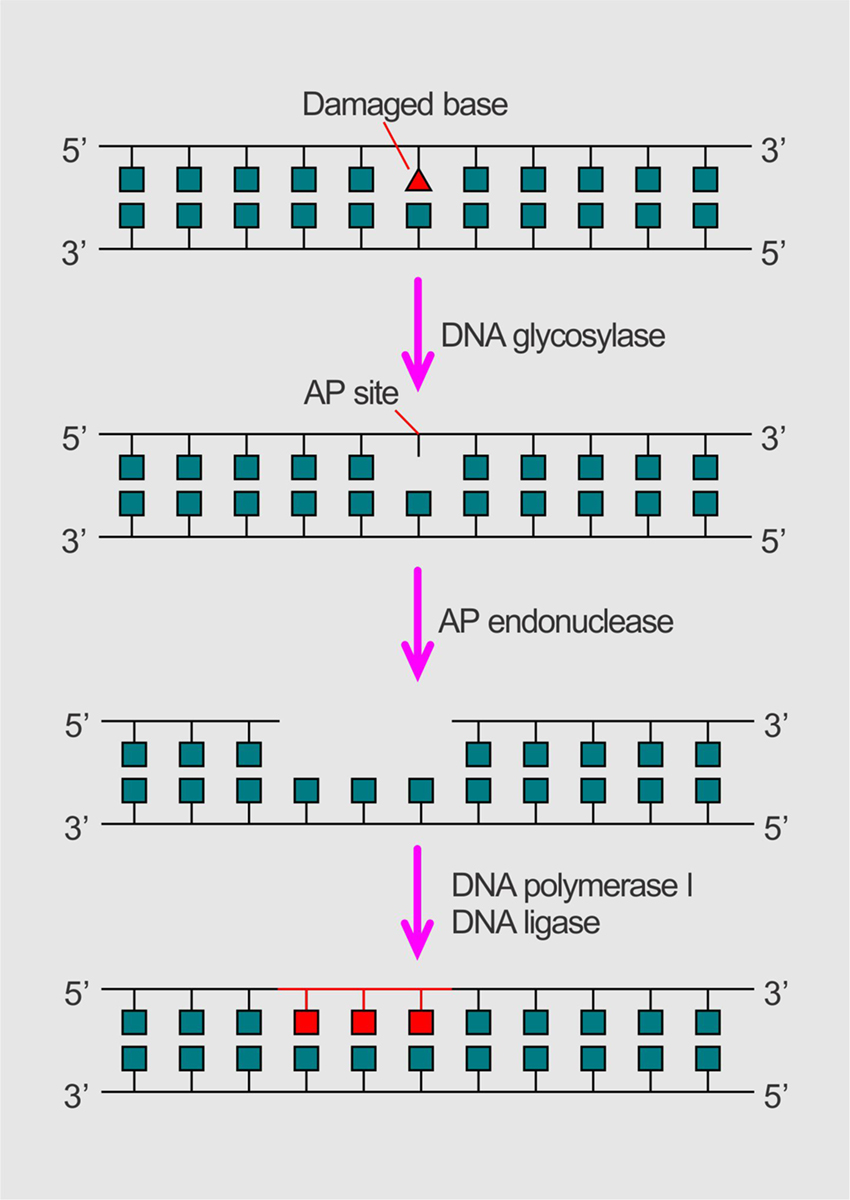Sun Damage and Pigmentation
Ultraviolet light accounts for the majority of the symptoms of early onset aging. The repeated exposure to excess UV light can cause DNA damage, inflammation and oxidative stress. The sun’s UV rays are important for life on Earth, yet some have genetic predispositions that keep them from having an effective protective barrier. Genetic predispositions also allow for free radical production from UV radiation to accumulate faster than it can be removed.
Optimal Functioning
DNA repair genes help bring DNA repair components together at the site of action to help repair DNA damage and clean up oxidative-induced DNA damage caused by ionizing radiation/UV rays. Repair of DNA is always ahead of the rate of DNA damage.
Dysfunction
Dysfunction occurs when damage is dominant over repair. This can be caused by too much exposure to UV radiation or a defective gene. You may have a genetic inefficiency causing a lack of working enzymes or proteins to clean up the damage left accumulating in DNA and to protect from further damage.
Symptoms include:
- Blemishes and freckles
- Pigmentation
- Skin thinning and fine lines
- Redness
- Broken Capillaries
- Rough Surface Area
Supplements
- D3 Active 5000 helps protect and repair the DNA. You need a healthy source of vitamin D3 without the harmful effects of UV rays over-stimulating DNA damage and accumulating free radicals. Absorption of vitamin D3 from the sun decreases with age.
- Arctic Omega Krill helps with inflammation and the astaxanthin is a very powerful antioxidant that helps defend against UV. Reduces damage caused by UV.
- Pycnogenol (sold at Medical Detective store) protects skin from UV-induced damage.
- ALAmed CR helps to improve collagen protective mechanisms along with promoting optimal mitochondrial function (ATP). Improved ATP production promotes collagen synthesis. When you have ingredients that promote ATP production, you must have adequate antioxidants to quench the free radicals produced by the mitochondria. This product is a powerful antioxidant and will neutralize the free radicals. Other benefits include blood glucose and insulin support, detoxification of plastics and heavy metals, and antioxidant support.
- Beta Carotene (sold at Medical Detective store) protects against sunburn, a sign of DNA damage that has been accelerated past its repair mechanisms.
- Lycopene (sold at Medical Detective store) protects against sunburn, a sign of DNA damage that has been accelerated past its repair mechanisms.
- E-ssential has photoprotective properties.
- Omega Platinum EC helps to inhibit the inflammatory cytokines such as (IL1, IL6, and TNF a1) that can be activated by ionizing radiation. It upregulates anti-inflammatory cytokine IL-10 and suppresses TH17 cells that negatively affect the immune system.
- ResveraTri protects against UVB radicals.
- Circuvasc protects and supports blood vessels from indirect damage caused by sun-induced oxidation.
- CollaGENerate supports and protects collagen from indirect damage of MMP’s caused by sun-induced oxidation.
- Synovial Active supports and protects hyaluronic acid from indirect damage of MMP’s caused by sun-induced oxidation.
- BioFlav C supports and protects collagen and blood vessels from indirect damage of MMP’s caused by sun-induced oxidation.
Types of UV- Induced DNA DAMAGE
There are three bands of UV rays emitted by sun: UVA, UVB and UVC. We will only be discussing UVB and UVA because UVC cannot penetrate through the ozone layer.
UVA
UVA causes indirect damage (lesions) to the DNA by way of Reactive Oxygen species (ROS). (See section below about 8oxoG.) UVA penetrates the deeper parts of the dermis and the rays can be intensified by cloudy and overcast days. The effects of these rays become more apparent years down the road as they go deep into layers of skin, damaging the dermis. Fluorescent lighting emits light energy in the range of UVA and can cause darkening of freckles. It is important to wear UVA sunscreen in fluorescent-lit buildings to prevent any damage from the UV light energy emitted. [1]
UVB
Direct absorption of UVB generates DNA photoproducts that cause lesions to DNA. For example, this causes cross-linking between adjacent cytosine and thymine bases in DNA (creating pyrimidine dimers that damage DNA). UVB effects are more immediately visible. The rays do not travel as deep into the skin because the spectrum isn’t strong enough. It does its damage more superficially and causes sunburns, peeling, pigmentation, swelling, and browning of the skin.
“DNA photoproducts generated upon direct absorption of UVB (280-320nm), UVA (320-400nm) can indirectly cause oxidative DNA damage in the form of oxidation of guanine (8-hydroxyguanine) and single-strand breaks via reactive oxygen species generated after the absorption of light energy by cellular chromophores.” [2]
DNA 101
DNA, deoxyribonucleic acid, is the hereditary material in humans and other living organisms. DNA is found in the nucleus (nuclear DNA) and mitochondria (mitochondrial DNA) of cells.
The DNA structure can be compared to a ladder. The backbone of the DNA would be the two parallel sides. In between the side structures of the DNA are rungs that run up and down it. If you were to twist this ladder you would get something that looks like the formation of the double helix of DNA.
DNA is made of repeating subunits called nucleotides.
Nucleotides contain:
1. Phosphate and 2. Sugar (Deoxyribose)
Appearing as the sides of the ladder.
3. Base Pairs
Found between the sides of the ladder.
Nitrogen Base Pairs, ATGC, are held together by hydrogen bonds. Base pairs are joined by a connection of adenine to thymine, and guanine to cytosine. Bases make up the code of your genetics. Bases are very sensitive to chemicals, carcinogens, and ROS induced by UV and other sources. The bases can form lesions (adducts), which can lead to trouble down the road. It’s known as DNA base modification.











